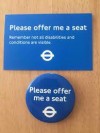The term Spina Bifida refers to separation in the bones of the spinal column, exposing nerves.
Physical consequences depend upon the lesion and the amount of damage to the spinal cord.
Bowel and bladder control may be affected.
The cause of Spina Bifida is unclear but the folic acid campaign in the UK has been very effective in reducing the number.
SEaTSS can support students with this condition.
To refer to SEATSS please use this link:
https://eforms.redbridge.gov.uk/single-point-of-access-referral-form-for-education-support/
National Center for Health, Physical Activity and Disability have produced a range video's showing some warm up, aerobic, and stretching exercises- a really useful link to share with PE staff. …
Tomcat Trikes in action
A variety of stretches for beginner wheelchair basketball players, but could be usd with students who are in a wheelchair. Always ensure you seek advice for student's physiotherapist if you …

Available from:
TfL have recently introduced a badge to help Adults and Children who may have difficulty standing/ waiting on all TfL transport. It is designed to be supportive for hidden disabilities and medical conditions. The badges are free- you do notneed…
Cranium bifida
The bones of the skull do not form correctly. The sac that forms is called an encephalocele.
This sac can contain cerebro-spinal fluid and in some cases part of the brain, this causes brain damage.
Spina Bifida can cause
Spina bifida cystica (cyst like)
Meningocele- this is the least common form. A sac containing tissues covers the spinal cord and cerebro fluid. Damage rarely affects function.
Spina bifida occulta (hidden) is a very mild, more common form where the outer part of the vertebrae are not formed completely.
The higher the lesion the greater the area affected so it is important to establish the position of the lesion.
Pupils with SB will need help to manage mobility & incontinence.
Assisting the pupil with transferring from chair to floor to wheelchair.
Some pupils will have to use a catheter to empty their bladder, focus upon developing independence with this task, pupils often achieve this by 8 / 9 yrs.
Lack of sensation can mean pupils are not aware of pressure sores/ skin damage therefore monitoring of skin on legs and feet is important. Monitor skin condition.
Pupils should be taught to check their bodies for sores/ broken skin.
Avoid a pupil with SB sitting next to heat source such as a radiator as pupils can be unaware if their limb is touching the heat source causing burn or scald.
They should also learn never to sit next to any heat source such as a radiator.
Plan and risk assess all out of school visits.
Pupil may need support when sitting on the floor for a length of time.
Subtle support for care needs, provide space for personal effects in the toilet/ personal bag.
Whizz-Kidz is a charity aiming to provide disabled children and young customised mobility equipment, training, advice and life skills.
This Charity provides equipment to children that is not available on the NHS. They also run Wheelchair training courses/ Mobility centres in Dagenham and Havering.
A UK wide charity providing advice, information and support to parents of all disabled children.
Here is a useful summary outlining who could apply and the criteria.